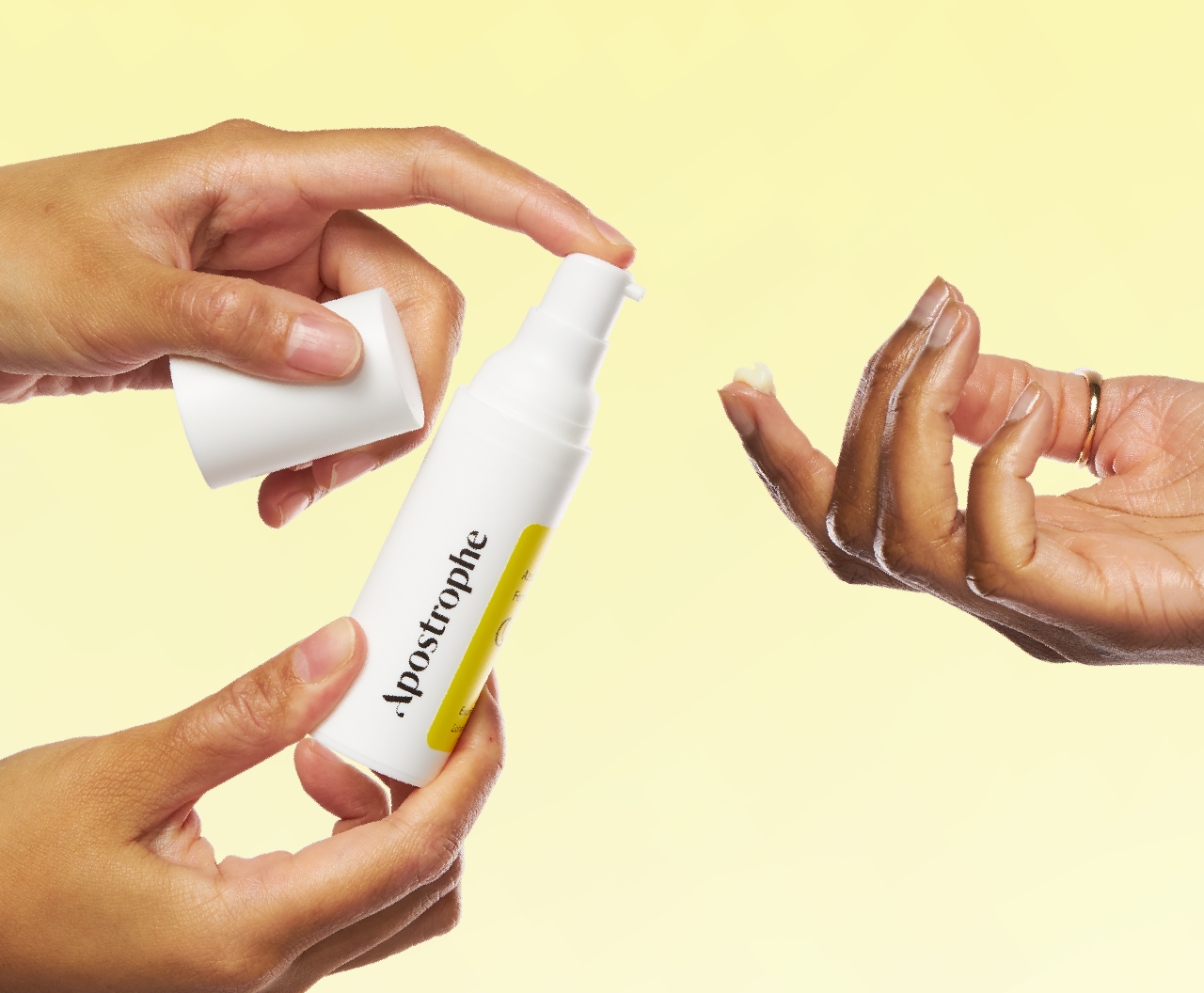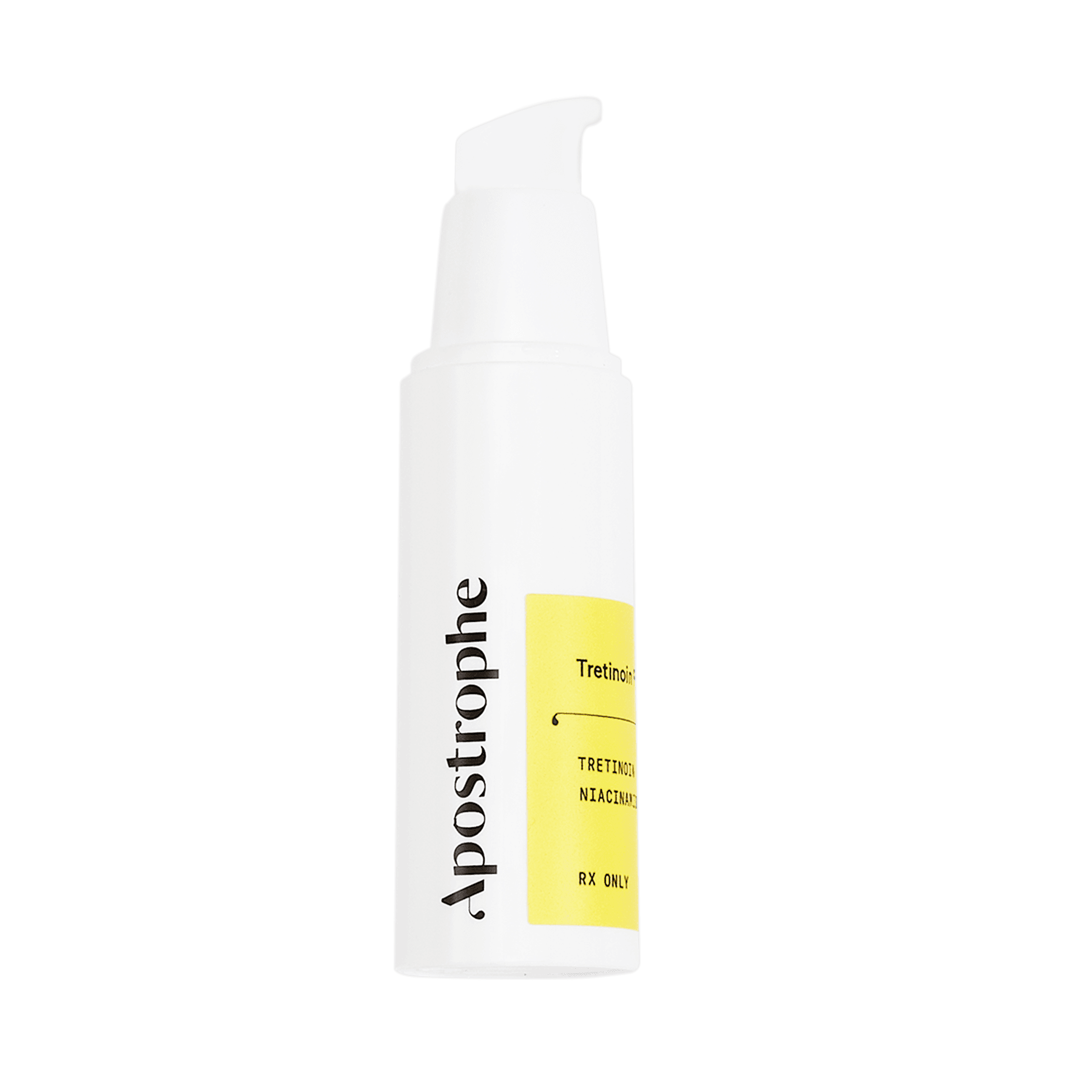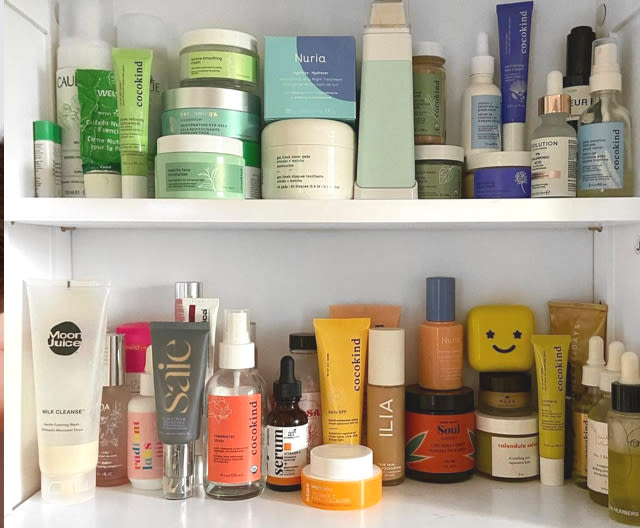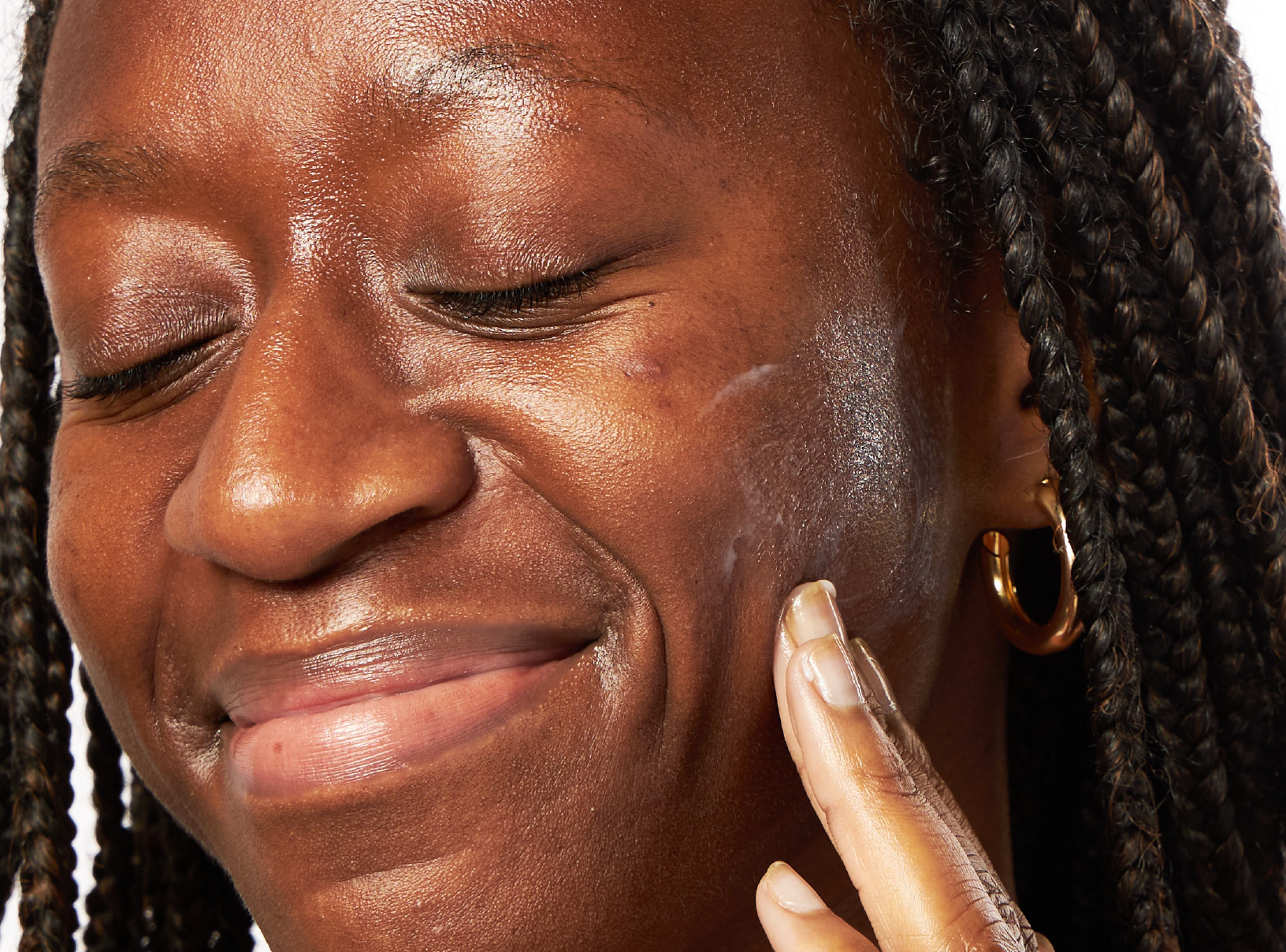Apostrophe Treatments
Where Can You Buy Tretinoin Cream?


SHARE
Apostrophe Treatments
Where Can You Buy Tretinoin Cream?
Medically reviewed by Kristin Hall, FNP
Written by Apostrophe Team
Last updated 8/1/2024
Chances are, if you’ve looked into anti-aging or acne treatments before, you’ve come across tretinoin cream. Tretinoin cream is arguably one of the best anti-aging and acne treatments on the market, and there’s a reason why many dermatology providers consider it the gold standard first-line treatment.
However, it can’t just be bought anywhere. In fact, it requires a prescription from a certified dermatology provider. Luckily, getting your hands on some isn’t impossible.
Discover where and how you can buy tretinoin cream.
What Is Tretinoin Cream?
Tretinoin cream is a part of the retinoid family and is made up of vitamin A and its natural derivatives.
Tretinoin cream works by promoting skin shedding, which sounds odd, but actually allows your skin to turn over old skin cells and replace them with new ones. These new skin cells help keep your skin fresh and are a part of the reason why the topical cream version works for acne use and anti-aging use.
Acne Treatment
Given its ability to speed up skin cell turnover, tretinoin works well as an acne treatment because it can take irritated, inflamed skin with acne and promote new skin generation. It also works as an acne treatment due to its ability to clear clogged hair follicles of dead skin.
Anti-aging treatment
Tretinoin cream is also used topically on the skin to build collagen and reduce deep wrinkles. It is extensively researched for its impact on photoaging, also known as sun damage.
In short-term studies, tretinoin was found to help thicken skin and improve wrinkles. While for longer-term treatment (over six months) tretinoin does the same, but helps with hyperpigmentation, as well.
With aging, one study showed promising results that tretinoin may change the structure of — and help smooth out — skin that’s been around the block a few times. However, more studies are needed to confirm this.
Why Do Dermatologists Love Tretinoin Cream?
Many dermatologists support the use of tretinoin cream because it has been widely investigated by researchers on its benefits for the skin.
In fact, tretinoin has been used in dermatology since the 1960s, respectively. However, it wasn’t until the 1980s that researchers began to study its potential for the treatment of aged skin by exposure to sunlight.
The first impactful study was in 1984, which showed tretinoin cream helped produce new collagen on the skin of mice — and, consequently, fewer wrinkles.
By the early ’90s, different researchers had conducted various studies measuring tretinoin over the course of one and three months, six months, and a year or longer. And by the mid-’90s researchers were beginning to understand tretinoin's molecular basis and how it impacted skin aging — as well as looking at tretinoin as a treatment of acne.
In almost all of the studies, applying tretinoin impacted the skin's brightness, collagen, dark spots, and fine lines. The degree to which it changed or improved depends on the amount of time it was used, how much of it was used, and other research factors.
Do I Need a Prescription For Tretinoin?
Tretinoin is only available by prescription in the U.S. It’s a bummer, but it’s for good reason — it comes with some potentially rough side effects (skin irritation, peeling, etc.) during the first few weeks of use.
So, if you want the good stuff, you’re going to have to schedule some time with your healthcare provider or preferred dermatology professional. That’s the bad-ish news.
The good news is that tretinoin may be the big dog, but it’s not the only retinoid out there. Retinol, for instance, is found in many over-the-counter skin care products and has also proven effective in the treatment of some of the lighter effects of photoaging, acne, etc. — usually with a much less severe side effects profile.
It’s not as clinically effective as tretinoin, but it packs plenty of punch for those lesser skin woes we experience from time to time.
Where Can I Buy Tretinoin?
Still convinced tretinoin is the answer to all your skincare problems? Even though it’s firmly planted in the “prescription medications” column at your local pharmacy, getting your hands on some isn’t difficult.
As we mentioned above, you’re going to need to schedule time with your healthcare provider or trusted dermatology practitioner. You can do this the old-school way by calling up the office and squeezing yourself into their packed schedule and taking time out of your day to make it happen.
You can also schedule an appointment with a dermatology professional online from the discreet comfort of your home, at your convenience. We know — tough decision to make.
Whichever route you choose, a professional will allow you the space to talk about your skin concerns and will help guide you through what you need to do to get the results you want — whether that be through prescription retinoids, over-the-counter retinol, or through another means.
If you have questions about the cost, you can read our blog on tretinoin cream price.
Why Tretinoin May Not Be For Everyone: Side Effects
Although tretinoin is thoroughly researched, it isn’t for everyone — primarily because of the side effects.
Tretinoin cream may cause pain, skin irritation, skin redness, and a sore throat.
In addition to those particular side effects, it’s generally not recommended for certain groups.
For instance, you can’t use tretinoin while being pregnant or considering pregnancy, as it’s unsafe and may potentially cause birth defects in fetuses.
If you’re pregnant or are considering becoming pregnant while using tretinoin, you should talk to your healthcare provider. If it’s not the right time for tretinoin, they’ll be able to recommend something else.
Tretinoin Alternatives
It’s very important to speak with a licensed dermatology professional or healthcare provider about your best options and consult with them before using something like a tretinoin cream. They’ll be your primary source for medical advice regarding tretinoin.
If you do find tretinoin cream to not be a good fit, there are plenty of other options for you to consider:
Adapalene
Adapalene, another drug in the retinoid family, is a good alternative as it’s less potent and thus can be less irritating for sensitive skin.
Despite it being less potent, it still helps with acne — namely, acne vulgaris.
In one study involving 503 people with moderate to severe inflammatory acne, adapalene was effective at reducing the overall amount of acne, as well as non-inflammatory lesion count.
The other thing that’s great about adapalene is there are over-the-counter options you can look for in a local pharmacy or drugstore.
Tazarotene
Another retinoid, tazarotene is an effective treatment for acne. Tazarotene helps reduce overall acne of different kinds.
However, similar to tretinoin, it is available by prescription only.
Moisturizers
Moisturizing is important at any stage of life and can help keep your skin from looking dried out.
One moisturizing option is hyaluronic acid, which can be used as a topical product or an injection. Find a moisturizer you like that you’ll use every day.
Want to learn more about other anti-aging treatments? Check out these top wrinkle treatments.
Finding the Right Skin Treatment
Ultimately, the hope is one of these gets you a bit closer to finding the right treatment for you.
Tretinoin cream does have extensive research regarding its effects on skin health — both for acne and aging. But that doesn’t necessarily mean it’s a fit for everyone.
Getting your hands on it also isn’t as easy as taking a stroll down the cosmetics aisle at your local pharmacy. You’ll need a prescription.
If that sounds daunting or you don’t think your skin issues are severe enough to warrant tretinoin, there are plenty of alternatives on the market better suited to your needs.
Either way, your first step should be meeting with a skincare pro. They’ll talk to you about things like your medical history, experience with acne (and other dermatological issues), and even your family history, and will have the knowledge and wisdom to help you figure out what your next move on the path to skin Nirvana should be.
*A note on benzoyl peroxide. In March 2024, Valisure shared results of a study that showcased that benzene can form in benzoyl peroxide (BPO) products. We currently recommend avoiding benzoyl peroxide products until the FDA provides more guidance on the safety of BPO.
Yoham AL, Casadesus D. Tretinoin. updated 2020 dec 5. In: StatPearls internet. Treasure Island (FL): StatPearls Publishing; 2021 Jan-. Retrieved from: https://www.ncbi.nlm.nih.gov/books/NBK557478/
Rathi S. K. (2011). Acne vulgaris treatment : the current scenario. Indian journal of dermatology, 56(1), 7–13. Retrieved from: https://www.ncbi.nlm.nih.gov/pmc/articles/PMC3088940/
Mukherjee, S., Date, A., Patravale, V., Korting, H. C., Roeder, A., & Weindl, G. (2006). Retinoids in the treatment of skin aging: an overview of clinical efficacy and safety. Clinical interventions in aging, 1(4), 327–348.Retrieved from: https://doi.org/10.2147/ciia.2006.1.4.327
Kligman LH, Duo CH, Kligman AM. Topical retinoic acid enhances the repair of ultraviolet damaged dermal connective tissue. Connect Tissue Res. 1984;12(2):139-50. Retrieved from: https://pubmed.ncbi.nlm.nih.gov/6723309/
Fisher GJ, Datta SC, Talwar HS, Wang ZQ, Varani J, Kang S, Voorhees JJ. Molecular basis of sun-induced premature skin ageing and retinoid antagonism. Nature. 1996 Jan 25;379(6563):335-9. Retrieved from: https://pubmed.ncbi.nlm.nih.gov/8552187/
Nyirady J, Bergfeld W, Ellis C, Levine N, Savin R, Shavin J, Voorhees JJ, Weiss J, Grossman R. Tretinoin cream 0.02% for the treatment of photodamaged facial skin: a review of 2 double-blind clinical studies. Cutis. 2001 Aug;68(2):135-42 Retrieved from: https://pubmed.ncbi.nlm.nih.gov/11534915/
Sumita JM, Leonardi GR, Bagatin E. Tretinoin peel: a critical view. An Bras Dermatol. 2017 May-Jun;92(3):363-366. Retrieved from: https://www.ncbi.nlm.nih.gov/pmc/articles/PMC5514577/
Leyden, J. J. (2020). Effects of topical tretinoin on non-sun-exposed protected skin of the elderly: Over 26 years later. Journal of the American Academy of Dermatology, 82(3), 776-777. Retrieved from: https://www.jaad.org/article/S0190-9622(18)32466-6/fulltext#secsectitle0095b
Stein Gold, L., Weiss, J., Rueda, M. J., Liu, H., & Tanghetti, E. (2016). Moderate and Severe Inflammatory Acne Vulgaris Effectively Treated with Single-Agent Therapy by a New Fixed-Dose Combination Adapalene 0.3 %/Benzoyl Peroxide 2.5 % Gel: A Randomized, Double-Blind, Parallel-Group, Controlled Study. American journal of clinical dermatology, 17(3), 293–303. Retrieved from: https://www.ncbi.nlm.nih.gov/pmc/articles/PMC4863916/
Thielitz, A., Abdel-Naser, M.B., Fluhr, J.W., Zouboulis, C.C. and Gollnick, H. (2008), Topical retinoids in acne – an evidence-based overview. JDDG: Journal der Deutschen Dermatologischen Gesellschaft, 6: 1023-1031. Retrieved from: https://onlinelibrary.wiley.com/doi/10.1111/j.1610-0387.2008.06741.x
Salwowska, N.M., Bebenek, K.A., Żądło, D.A. and Wcisło-Dziadecka, D.L. (2016), Physiochemical properties and application of hyaluronic acid: a systematic review. J Cosmet Dermatol, 15: 520-526. Retrieved from: https://onlinelibrary.wiley.com/doi/full/10.1111/jocd.12237
Walker K, Basehore BM, Goyal A, et al. Hyaluronic Acid. updated 2021 nov 15. In: StatPearls internet. Treasure Island (FL): StatPearls Publishing; 2022 Jan-. Available from: https://www.ncbi.nlm.nih.gov/books/NBK482440/
Shop this post

Tretinoin
Like what you just read? Sign up for our email list to get the scoop on skincare science delivered straight to your inbox.

Education
What is milia?
What is milia? Today, we’re jumping into one type of bump that you may have heard about most commonly in infants — milia.
Read More
Education
Best moisturizer for acne-prone skin
If you have combination acne-prone skin, figuring out which moisturizer is best for your skin might be tough. In this guide, we break down the best moisturizer for combination, acne-prone skin.
Read More
Education
How to build a face care routine
As you get into skincare, it might seem overwhelming, especially trying to figure out the order you're supposed to apply products in. Below, we detail how to build a face care routine for your skin!
Read More
